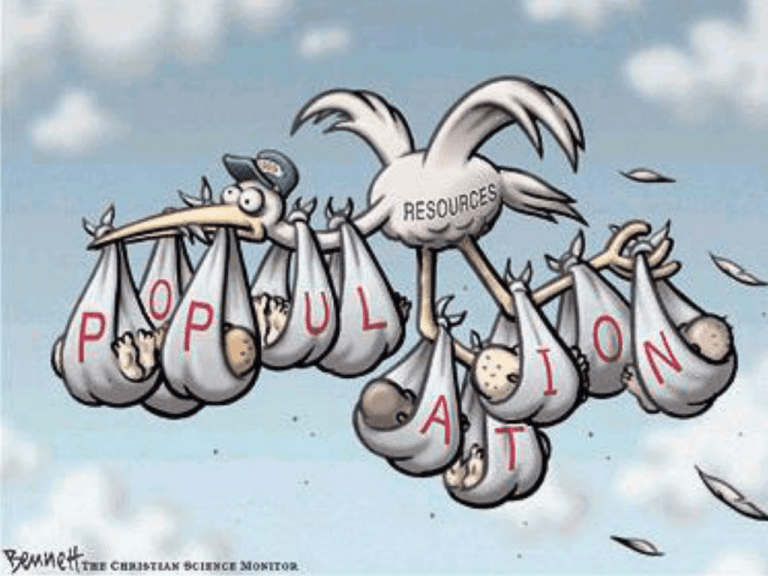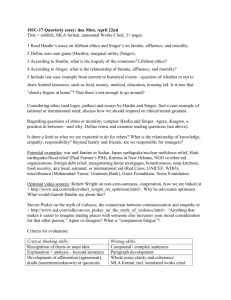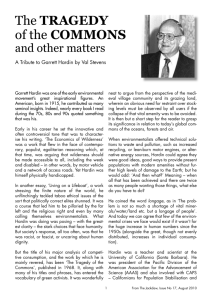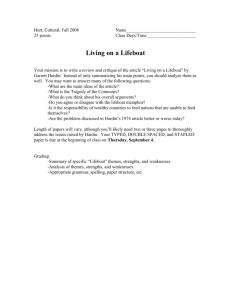Population & Migration
advertisement

75% water 25% land ½ is too dry or too cold for large-scale agriculture 75% of world population lives along a river or a coastline. . . or 5% of the land area Or. . . ½ of a ½ of a ¼ POPULATION Population concentrations 5. NORTHEAST NORTH AMERICA 3. EUROPE 2. SOUTH ASIA 1. EAST ASIA 4. SOUTHEAST ASIA POPULATION Population density Arithmetic density Bangladesh Netherlands India China Virginia 2000 Virginia 2010 United States World Longwood = # people total land area Total Population Total Area (c. 2015) (square miles) 149,772,364 56,976 16,676,126 16,164 1,210,193,422 1,222,559 1,339,724,852 3,696,117 7,078,515 39,597 8,001,024 39,597 308,745,538 3,531,905 7,072,887,517 57,505,734 3,248 0.12 Arithmetic Density (persons/ square mile) 2,629 1,032 990 362 179 202 87 123 27,067 D. Hardin POPULATION Population density Physiologic density Agricultural density Bangladesh Netherlands India China Virginia 2000 Virginia 2010 United States World Longwood = # people total arable land = # people total farmed land Total Population Total Area Arable Land (c. 2015) (square miles) (square miles) 149,772,364 56,976 30,502 16,676,126 16,164 4,118 1,210,193,422 1,222,559 610,601 1,339,724,852 3,696,117 419,469 7,078,515 39,597 12,705 8,001,024 39,597 12,705 308,745,538 3,531,905 658,304 7,072,887,517 57,505,734 16,000,049 3,248 0.120 0.068 Arithmetic Physiologic Density Density (persons/ (persons/ square mile) square mile) 2,629 4,910 1,032 4,050 990 1,982 362 3,194 179 557 202 630 87 469 123 442 27,067 47,765 D. Hardin POPULATION Population density Carrying Capacity: The ability of a given amount of land To support a given number of people At a given level of technology D. Hardin POPULATION Population density Egypt Egypt 2011 Population – 80,410,017 Total Land Area – 390,117 sq. mi. Arable Land – 12,873 sq. mi. (3.3%) Farmed Land 1,950 sq. mi. (0.5%) Arithmetic Density 206 persons/sq. mi. (just a bit higher than Virginia) D. Hardin POPULATION Population density Egypt Physiologic Density: 6,246 persons/sq. mi. Agricultural Density: 41,236 persons/sq. mi.! D. Hardin POPULATION Population change Natural Population Change Migration TP = OP + B – D + I - E Total Population Original Population Births Deaths Immigra- Emigration tion D. Hardin POPULATION Population change Rates of change Highest – Niger: 3.52% Lowest – Moldova: -0.68% World average – 1.1% (down from 1.2%) It’s all in the numbers. Take two countries with identical growth rates (.42%)… Grenada: 105,303 X .42% = 442 people annually China: 1,353,600,687 X .42% = 5,685,122 people annually That’s 70% of the population of Virginia every year! World: 7,072,887,517 X 1.1% = 77,801,762 people annually That’s nearly 10 Virginias every year! D. Hardin POPULATION Population change 2000 2000 2050 2050 D. Hardin POPULATION Demographic Transition High Stage 1 Stage 2 Stage 3 Stage 4 Stage 5 Low Rate Birth rate Total population Death rate Time D. Hardin POPULATION Population Pyramids D. Hardin POPULATION Demographic Transition & population pyramids High Stage 1 Low Rate Birth rate Total population Death rate Time D. Hardin POPULATION Demographic Transition Stage 1 D. Hardin POPULATION Demographic Transition & population pyramids High Stage 1 Stage 2 Low Rate Birth rate Total population Death rate Time D. Hardin POPULATION Demographic Transition Stage 2 Nigeria Libya Iraq 2003 D. Hardin POPULATION Demographic Transition Stage 2 [Youth serves the Fuhrer] D. Hardin POPULATION Demographic Transition Stage 2 Industrial Revolution Medical Revolution Hans Rosling video D. Hardin POPULATION Demographic Transition & population pyramids High Stage 1 Stage 2 Stage 3 Low Rate Birth rate Total population Death rate Time D. Hardin POPULATION Demographic Transition Stage 3 India Egypt Israel D. Hardin POPULATION Demographic Transition Stage 3 D. Hardin POPULATION Demographic Transition Stage 3 D. Hardin POPULATION Demographic Transition Stage 3 D. Hardin POPULATION Demographic Transition Stage 3 D. Hardin POPULATION Demographic Transition Stage 3 Brazil 1970s 1980s 1990s 2000s POPULATION Demographic Transition Stage 3 NUMBER OF CHILDREN IN THE LAST THREE GENERATIONS 60 50 Percentage 40 Grandparents 30 Parents You 20 10 0 1-2 3-4 5-6 6-7 >7 POPULATION Demographic Transition & population pyramids High Stage 1 Stage 2 Stage 3 Stage 4 Low Rate Birth rate Total population Death rate Time D. Hardin POPULATION Demographic Transition Stage 4 Canada Australia United States D. Hardin POPULATION Demographic Transition Stage 4 …while allowing seniors their independence… Social Security decreases poverty among the elderly… Per capita Social Security expenditures and poverty rate for 65+, 1959-2009 …and creating the nuclear family. D. Hardin POPULATION Demographic Transition & population pyramids High Stage 1 Stage 2 Stage 3 Stage 4 Stage 5 Low Rate Birth rate Total population Death rate Time D. Hardin POPULATION Demographic Transition Stage 5 Japan Germany Switzerland D. Hardin POPULATION Demographic Transition Stage 5 Germany Germany's Demographic Transition 1900-2010 40 30 25 20 WW I Stage 2 moving to Stage 3 Hitler’s baby boom WW II 1972 15 10 5 0 19 0 19 0 0 19 5 1 19 0 1 19 5 2 19 0 2 19 5 3 19 0 3 19 5 4 19 0 4 19 5 5 19 0 5 19 5 6 19 0 6 19 5 7 19 0 7 19 5 8 19 0 8 19 5 9 19 0 9 20 5 0 20 0 0 20 5 10 Births/deaths per 1,000 35 Crude birth rate Crude death rate D. Hardin POPULATION Demographic Transition Stage 5 Germany’s “Guest Workers” D. Hardin POPULATION Demographic Transition Stage 5 Germany’s “Guest Workers” D. Hardin POPULATION Demographic Transition Stage 5 Germany’s “Guest Workers” D. Hardin POPULATION Demographic Transition U.S. population pyramids D. Hardin POPULATION Demographic Transition Geography of Ageing in the US “Ageing in place” Retirement regions D. Hardin POPULATION Demographic Transition Ageing U.S. population D. Hardin POPULATION Population change Natural Population Change Migration TP = OP + B – D + I - E Total Population Original Population Births Deaths Immigra- Emigration tion D. Hardin POPULATION Migration Factors Push (emigration) Pull (immigration) Political* Economic Environmental Political Economic Environmental Forced or voluntary? 1. 2. 3. 4. 5. 6. 7. 8. Migrants on the Oregon Trail (1836-1869)? Mormon Migration (1838-1867)? African-American “Great Migration” (1910-1970)? Okies (1930s)? Retiring to Florida (1950-present)? Ethnic cleansing in the former Yugoslavia (1991-1995)? Millennial urban renaissance (2000-present)? Europe’s Syrian refugee problem (2015)? * Denotes a systemic influence, e.g. racism, ethnic, religious, or political persecution, war, etc. D. Hardin POPULATION Migration Emigration & Immigration "Give me your tired, your poor, Your huddled masses yearning to breathe free, The wretched refuse of your teeming shore. Send these, the homeless, tempest-tossed to me. I lift my lamp beside the golden door." D. Hardin POPULATION Migration Emigration & Immigration Average Migrant Profile • Young – average in the 20s (age most willing to do hard, distasteful work) • Educated – average some high school; the best and brightest coming to US (“brain drain”) • Motivated – decision to migrate is more than the average person is willing to risk; willing to endure hardship so their children will have better lives (“American Dream”) D. Hardin POPULATION Migration Immigration Virginia Region of Birth for Virginia’s Foreign Born 1990 Other 8% 2000 Other 10% Europe 22% Latin Am erica 25% 2010 Latin Am erica 33% Asia 45% Other 11% Europe 15% Asia 42% Latin Am erica 36% Europe 12% Asia 41% D. Hardin POPULATION Migration Immigration Virginia Hispanics e Population Pyramids for Hispanic Citizens and Immigrants in Virginia, 2006 D. Hardin POPULATION Migration Immigration U.S.-Mexico border San Diego San Ysidro United States Mexico Tijuana D. Hardin POPULATION Migration Immigration Hispanic population: U.S., 1980-2007 D. Hardin POPULATION Migration Immigration Virginia Hispanics 2000 2014 POPULATION Migration Immigration Virginia Hispanics Loudoun – 14.0% Fairfax – 16.5% Fairfax City – 17.0% Arlington – 15.9% Alexandria City – 16.8% Winchester City – 16.6% Harrisonburg City – 19.0% Manassas City – 34.0% Manassas Park City – 33.4% Prince William – 22.4% Stafford – 11.5% Fredericksburg City – 11.0% Galax City – 14.6% D. Hardin POPULATION Migration Internal D. Hardin POPULATION Migration Internal Exurban growth D. Hardin POPULATION Migration Internal D. Hardin POPULATION Migration Local Richmond Metropolitan Area White Flight Stage 2 & New arrivals 1990s-00s City Inner suburbs Outer suburbs White Flight Stage 1 1970s-80s POPULATION Demographic Transition & population pyramids High Stage 1 Stage 2 Stage 3 Stage 4 Stage 5 Low Rate Birth rate Total population Death rate Time D. Hardin




